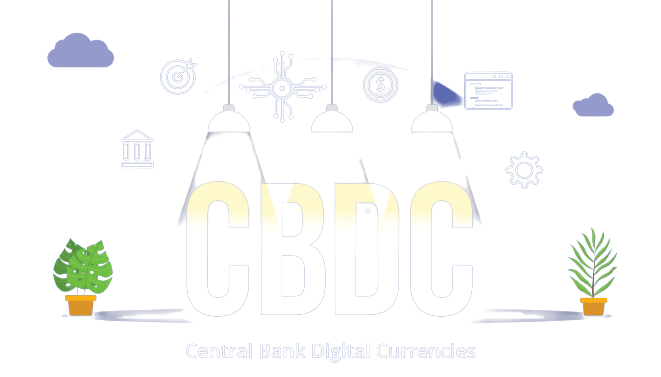
Central Bank Digital Currency (CBDC) refers to a digital form of a country’s national currency that is issued and regulated by the central bank. It is a new type of money that exists purely in digital form and is intended to be used for electronic transactions. Unlike traditional physical currency, CBDC operates on a digital platform, allowing individuals and businesses to make payments, store value, and conduct transactions using electronic devices such as smartphones and computers.
Purpose And Objectives Of CBDC
The introduction of CBDC is driven by several purposes and objectives, which can vary from country to country. Some common purposes and objectives include:
Enhancing Payment Systems: CBDCs can facilitate faster and more efficient payment transactions, particularly cross-border payments and remittances. They can offer real-time settlement and reduce the need for intermediaries, thereby streamlining the payment process.
Financial Inclusion: CBDCs can help extend access to financial services to underserved and unbanked populations. Since CBDCs can be accessed using basic smartphones, individuals without traditional bank accounts can participate in the financial system.
Monetary Policy: CBDCs provide central banks with new tools to implement and fine-tune monetary policy. They can enable more direct and targeted interventions, such as distributing funds to households in times of economic crises.
Reducing Costs: CBDCs have the potential to reduce the costs associated with printing, transporting, and securing physical currency. Moreover, they can contribute to reducing the costs of cash handling for banks and businesses.
Combating Illicit Activities: CBDCs can offer enhanced traceability and transparency of transactions, making it more challenging for illegal activities such as money laundering and terrorism financing to go unnoticed.
Innovation in Financial Services: The digital nature of CBDCs opens up possibilities for innovative financial products and services. Programmable money and smart contracts could automate transactions and facilitate complex financial operations.
Security and Fraud Prevention: CBDCs can be designed with robust security features, making them less susceptible to counterfeiting and fraud. Additionally, digital transactions can be more secure than physical cash transactions.
Economic Resilience: CBDCs could potentially enhance a country’s economic resilience by providing an alternative means of payment during disruptions to the traditional financial system, such as natural disasters or cyberattacks.
Cross-Border Transactions: CBDCs can simplify cross-border transactions by reducing the need for currency conversions and intermediaries. This could lead to more efficient and cost-effective international trade and finance.
Technological Innovation: CBDCs offer an opportunity for central banks to explore and adopt innovative technologies, such as blockchain or distributed ledger technology, which could have broader applications beyond digital currency.
These purposes and objectives highlight the multifaceted nature of CBDCs and how they can potentially reshape various aspects of financial systems and economies. However, it’s important to note that the implementation of CBDCs also comes with challenges and considerations, which need to be carefully addressed to ensure their successful integration into existing monetary and financial frameworks.
Types Of CBDC
A. Retail CBDC
Definition and Characteristics: Retail CBDC is a form of digital currency issued by a central bank that is available for direct use by the general public, including individuals and businesses. It’s essentially a digital equivalent of physical cash, allowing users to hold and transact with digital currency issued by the central bank.

User Accessibility: Retail CBDC is designed to be widely accessible. Users can hold and use it through digital wallets or accounts provided by the central bank or authorized financial institutions. It can be used for a range of transactions, including everyday purchases, peer-to-peer transfers, and online payments.
Use Cases and Benefits
Convenience: Retail CBDC provides a convenient way for individuals to make digital transactions without relying on intermediaries.
Financial Inclusion: It can extend financial services to unbanked and underbanked populations who might not have access to traditional banking services.
Reduced Transaction Costs: CBDC transactions can potentially be cheaper than traditional payment methods, especially for cross-border transactions.
Faster Settlement: Retail CBDC can enable real-time settlement, reducing the time it takes for transactions to be confirmed.
Security: CBDC transactions can be more secure than physical cash transactions, and the digital nature allows for more advanced security features.
Direct Monetary Policy Transmission: Central banks can have more direct influence over the economy by influencing the use of CBDCs.
Challenges and Concerns
Privacy: Balancing user privacy with the need to prevent illicit activities and ensure compliance with regulations.
Cybersecurity: Ensuring the security of digital wallets and preventing cyberattacks.
Operational Risks: Managing technical and operational challenges associated with widespread digital currency usage.
Financial Stability: Understanding potential impacts on bank deposits and credit intermediation.
User Education: Ensuring users understand how to use and secure their digital wallets.
B. Wholesale CBDC
Wholesale CBDC is a digital currency designed for use by financial institutions, primarily for interbank settlements and large-value transactions. It’s not intended for general public use like retail CBDC.
Limited Access to Financial Institutions: Wholesale CBDC is typically accessible only to authorized financial institutions, such as commercial banks and financial intermediaries.
Settlement of Interbank Transactions
Wholesale CBDC can streamline the settlement process for interbank transactions, making it faster and more efficient. It can potentially reduce counterparty risks and settlement delays associated with traditional systems.
Impact on Financial Markets
Wholesale CBDC can enhance the efficiency and transparency of financial markets. It might lead to the development of new financial products and services based on programmable money and smart contracts. Central banks might need to carefully manage the impact on liquidity and the stability of financial systems.
Motivations For CBDC Implementation
A. Enhancing Payment Systems
Real-Time Transactions: CBDCs can enable instantaneous and real-time transactions, improving the speed and efficiency of payments. This is particularly beneficial for retail transactions, e-commerce, and cross-border transfers, reducing the time required for settlement and enhancing the overall user experience.
Reduced Settlement Risk: By using CBDCs for transactions, the settlement process becomes more streamlined and less susceptible to risks associated with delayed or failed settlements. This can enhance the stability of the financial system and reduce the potential for systemic disruptions.
B. Financial Inclusion
Reaching Unbanked Populations: CBDCs can extend financial services to individuals who lack access to traditional banking services. Since CBDCs can be stored and transacted digitally, they provide an avenue for the unbanked and underbanked populations to participate in the formal financial system.
Lowering Barriers to Access Financial Services: CBDCs can significantly lower the entry barriers to accessing financial services. Individuals without physical bank branches nearby can use digital devices to access CBDC accounts, making basic financial services more accessible to a broader range of people.
C. Monetary Policy and Control
Improved Transmission Mechanisms: CBDCs offer central banks a more direct and efficient tool for implementing monetary policy. By having a digital representation of the national currency, central banks can influence economic activity more effectively by directly affecting the money supply and demand.
Implementing Negative Interest Rates: CBDCs can enable central banks to implement negative interest rates more effectively. With physical cash, individuals can choose to hold money outside the banking system to avoid paying interest. However, with CBDCs, central banks can impose negative interest rates directly on digital holdings, incentivizing spending and investment.
D. Combating Illicit Activities
Tracing and Tracking Transactions: CBDC transactions are recorded digitally, allowing for greater transparency and traceability of funds. This can aid in reducing tax evasion, money laundering, and other financial crimes, as transactions leave a clear and auditable trail.
Anti-Money Laundering (AML) and Counter-Terrorism Financing (CTF): CBDCs can incorporate advanced anti-money laundering and counter-terrorism financing measures. Central banks can impose transaction limits, monitor suspicious activities, and enforce strict identity verification procedures, making it more difficult for illicit funds to be moved through the financial system.
Key Components And Features Of CBDC
A. Digital Tokenization
Token-based vs. Account-based Systems
Token-Based CBDC: In a token-based system, CBDC units are represented as unique digital tokens, each with its own cryptographic signature. These tokens can be transferred directly between users and verified instantly.
Account-Based CBDC: In an account-based system, CBDC units are associated with user accounts. Transactions involve debiting and crediting these accounts. It’s akin to the traditional banking model but in a digital form.
Privacy Considerations
Token-Based Privacy: Token-based systems can offer a higher level of privacy as transaction details are not necessarily tied to user identities.
Account-Based Privacy: Account-based systems might provide less privacy since transactions are linked to user accounts, potentially raising concerns about user data protection.
B. Integration with Existing Payment Systems
Interoperability with Commercial Banks

CBDC should seamlessly integrate with existing banking systems, allowing for transfers between CBDC accounts and commercial bank accounts. Interoperability ensures that users can easily convert between CBDC and traditional currency held in banks.
Seamless Conversion between CBDC and Physical Currency
CBDC should be convertible to physical currency and vice versa to maintain flexibility for users who prefer or need physical cash.
C. Security and Authentication
Cryptographic Techniques
CBDC employs cryptographic techniques to secure transactions, digital signatures, and ownership records. Encryption ensures that only authorized parties can access and transact CBDC.
Prevention of Fraud and Cyber Threats
Robust security measures are essential to prevent counterfeiting, hacking, and unauthorized access. Multi-factor authentication, secure key management, and encryption are critical components.
D. User Identification and Verification
KYC (Know Your Customer) Procedures
CBDC systems typically require users to go through KYC procedures, verifying their identities to prevent illicit activities. KYC helps maintain regulatory compliance and prevents anonymity in transactions.
Balancing Privacy and Security
Striking a balance between privacy and security is crucial. While strong identity verification is needed for security, preserving user privacy is also important. Techniques like zero-knowledge proofs can be employed to validate user information without exposing sensitive data.
International Landscape Of CBDC Adoption
The adoption of CBDCs could influence the international use of currencies. Some CBDCs could become widely used for cross-border trade and investment, potentially altering the balance of global currency reserves. CBDCs have the potential to significantly reduce the time and costs associated with cross-border transactions. This could enhance financial inclusion and international trade, making it easier for individuals and businesses to transact across borders.
The global adoption of CBDCs raises challenges related to interoperability, regulatory coordination, and potential systemic risks. Harmonizing standards and regulations will be important to ensure smooth cross-border transactions. The international use of CBDCs might impact the effectiveness of monetary policy. If CBDCs held by non-residents affect a country’s money supply or interest rates, this could lead to unintended spillover effects.
The international landscape of CBDC adoption is dynamic and rapidly evolving. Countries are closely watching each other’s developments and exploring potential collaborative efforts to harness the benefits of CBDCs while addressing the challenges that arise on a global scale.
Future Outlook And Conclusion
CBDCs could lead to the creation of an entirely digital financial ecosystem, where transactions, payments, and savings are conducted electronically, revolutionizing how individuals and businesses interact with money. The programmable nature of CBDCs could lead to the development of innovative financial products and services, including smart contracts for automated payments, decentralized finance (DeFi) applications, and more sophisticated digital asset management tools.
CBDCs represent a significant development in the evolution of money and finance. While they offer numerous advantages, their successful implementation requires careful consideration of technological, regulatory, economic, and societal factors. As countries continue to explore and experiment with CBDCs, collaboration and innovation will be key to harnessing their potential and addressing the complexities they bring to the financial sector.